Multivariate Regression in Conjunction with GA-BP for Optimization of Data Processing of Trace NO Gas Flow in Active Pumping Electronic Nose
Abstract
1. Introduction
2. Methods
2.1. System Design
2.2. Modeling and Simulation
2.3. Correlation Discrimination between Pump Suction Flow and Sensor Response
2.4. Flow Correction Method
- (1)
- Multiple regression algorithm
- (2)
- GA-based BP neural network algorithm
- (3)
- Optimization algorithm based on MR and GA-BP
3. Experiment and Simulation Process
3.1. Experimental Equipment
3.2. Simulation Process
- (1)
- AIRPAK simulation process
- (2)
- ANSYS simulation process
3.3. Experimental Data Collection
4. Results and Discussion
4.1. AIRPAK Simulation Results
4.2. System Response
4.3. Comparison and Analysis of Different Pump Flows of Sampling Gas
4.4. Correction Results and Analysis of Gas Flow Data
- (1)
- Parameter selection and optimization based on MR and GA-BP optimization algorithm
- (2)
- Optimization algorithm’s flow capacity correction results based on MR and GA-BP
5. Conclusions
Supplementary Materials
Author Contributions
Funding
Institutional Review Board Statement
Informed Consent Statement
Data Availability Statement
Acknowledgments
Conflicts of Interest
References
- Ali, M.M.; Hashim, N.; Abd Aziz, S.; Lasekan, O. Principles and recent advances in electronic nose for quality inspection of agricultural and food products. Trends Food Sci. Technol. 2020, 99, 1–10. [Google Scholar]
- John, A.T.; Murugappan, K.; Nisbet, D.R.; Tricoli, A. An outlook of recent advances in chemiresistive sensor-based electronic nose systems for food quality and environmental monitoring. Sensors 2021, 21, 2271. [Google Scholar] [CrossRef]
- Tan, J.; Xu, J. Applications of electronic nose (e-nose) and electronic tongue (e-tongue) in food quality-related properties determination: A review. Artif. Intell. Agric. 2020, 4, 104–115. [Google Scholar] [CrossRef]
- Wilson, A.D. Diverse Applications of Electronic-Nose Technologies in Agriculture and Forestry. Sensors 2013, 13, 2295–2348. [Google Scholar]
- Kou, L.; Zhang, D.; Liu, D. A novel medical e-nose signal analysis system. Sensors 2017, 17, 402. [Google Scholar] [CrossRef]
- Lekha, S.; Suchetha, M. Recent advancements and future prospects on e-nose sensors technology and machine learning approaches for non-invasive diabetes diagnosis: A review. IEEE Rev. Biomed. Eng. 2020, 14, 127–138. [Google Scholar] [CrossRef] [PubMed]
- Moon, H.G.; Jung, Y.; Han, S.D.; Shim, Y.-S.; Shin, B.; Lee, T.; Kim, J.-S.; Lee, S.; Jun, S.C.; Park, H.-H. Chemiresistive electronic nose toward detection of biomarkers in exhaled breath. ACS Appl. Mater. Interfaces 2016, 8, 20969–20976. [Google Scholar] [CrossRef] [PubMed]
- Wilson, A.D. Advances in electronic-nose technologies for the detection of volatile biomarker metabolites in the human breath. Metabolites 2015, 5, 140–163. [Google Scholar] [CrossRef] [PubMed]
- Orzechowska, S.; Mazurek, A.; Świsłocka, R.; Lewandowski, W. Electronic nose: Recent developments in gas sensing and molecular mechanisms of graphene detection and other materials. Materials 2019, 13, 80. [Google Scholar] [CrossRef]
- Montuschi, P.; Santonico, M.; Mondino, C.; Pennazza, G.; Mantini, G.; Martinelli, E.; Capuano, R.; Ciabattoni, G.; Paolesse, R.; Di Natale, C. Diagnostic performance of an electronic nose, fractional exhaled nitric oxide, and lung function testing in asthma. Chest 2010, 137, 790–796. [Google Scholar] [CrossRef]
- van der Valk, R.J.; Baraldi, E.; Stern, G.; Frey, U.; de Jongste, J.C. Daily exhaled nitric oxide measurements and asthma exacerbations in children. Allergy 2012, 67, 265–271. [Google Scholar] [CrossRef]
- American Thoracic Society; European Respiratory Society. ATS/ERS recommendations for standardized procedures for the online and offline measurement of exhaled lower respiratory nitric oxide and nasal nitric oxide, 2005. Am. J. Respir. Crit. Care Med. 2005, 171, 912–930. [Google Scholar] [CrossRef] [PubMed]
- Dweik, R.A.; Boggs, P.B.; Erzurum, S.C.; Irvin, C.G.; Leigh, M.W.; Lundberg, J.O.; Olin, A.-C.; Plummer, A.L.; Taylor, D.R.; American Thoracic Society Committee on Interpretation of Exhaled Nitric Oxide Levels (FENO) for Clinical Applications. An official ATS clinical practice guideline: Interpretation of exhaled nitric oxide levels (FENO) for clinical applications. Am. J. Respir. Crit. Care Med. 2011, 184, 602–615. [Google Scholar] [CrossRef]
- Ignacio-Garcia, J.M.; Gonzalez-Santos, P. Asthma self-management education program by home monitoring of peak expiratory flow. Am. J. Respir. Crit. Care Med. 1995, 151, 353–359. [Google Scholar] [CrossRef] [PubMed]
- Kendrick, A.; Higgs, C.; Whitfield, M.; Laszlo, G. Accuracy of perception of severity of asthma: Patients treated in general practice. Br. Med. J. 1993, 307, 422–424. [Google Scholar] [CrossRef]
- Rapson, T.D.; Hall, G.L.; Sutherland, T.D. Could home-based FeNO measurements breathe new life into asthma management? J. Asthma 2019, 56, 910–913. [Google Scholar] [CrossRef]
- Bakker, E.; Telting-Diaz, M. Electrochemical sensors. Anal. Chem. 2002, 74, 2781–2800. [Google Scholar] [CrossRef]
- Dacres, H.; Narayanaswamy, R. A new optical sensing reaction for nitric oxide. Sens. Actuators B Chem. 2003, 90, 222–229. [Google Scholar] [CrossRef]
- Ding, L.; Ruan, Y.; Li, T.; Huang, J.; Warren-Smith, S.C.; Ebendorff-Heidepriem, H.; Monro, T.M. Nitric oxide optical fiber sensor based on exposed core fibers and CdTe/CdS quantum dots. Sens. Actuators B Chem. 2018, 273, 9–17. [Google Scholar] [CrossRef]
- Hetrick, E.M.; Schoenfisch, M.H. Analytical chemistry of nitric oxide. Annu. Rev. Anal. Chem. 2009, 2, 409. [Google Scholar] [CrossRef]
- Xu, T.; Scafa, N.; Xu, L.P.; Su, L.; Li, C.; Zhou, S.; Liu, Y.; Zhang, X. Electrochemical sensors for nitric oxide detection in biological applications. Electroanalysis 2014, 26, 449–468.22. [Google Scholar] [CrossRef]
- Cross, E.S.; Williams, L.R.; Lewis, D.K.; Magoon, G.R.; Onasch, T.B.; Kaminsky, M.L.; Worsnop, D.R.; Jayne, J.T. Use of electrochemical sensors for measurement of air pollution: Correcting interference response and validating measurements. Atmos. Meas. Tech. 2017, 10, 3575–3588. [Google Scholar] [CrossRef]
- Park, S.Y.; Kim, Y.; Kim, T.; Eom, T.H.; Kim, S.Y.; Jang, H.W. Chemoresistive materials for electronic nose: Progress, perspectives, and challenges. InfoMat 2019, 1, 289–316. [Google Scholar] [CrossRef]
- Khalili, B.; Boggs, P.; Bahna, S. Reliability of a new hand-held device for the measurement of exhaled nitric oxide. Allergy 2007, 62, 1171–1174. [Google Scholar] [CrossRef] [PubMed]
- Miki, H.; Matsubara, F.; Nakashima, S.; Ochi, S.; Nakagawa, K.; Matsuguchi, M.; Sadaoka, Y. A fractional exhaled nitric oxide sensor based on optical absorption of cobalt tetraphenylporphyrin derivatives. Sens. Actuators B Chem. 2016, 231, 458–468. [Google Scholar] [CrossRef]
- Rachel, M.; Biesiadecki, M.; Aebisher, D.; Galiniak, S. Exhaled nitric oxide in pediatric patients with respiratory disease. J. Breath Res. 2019, 13, 046007. [Google Scholar] [CrossRef]
- Horváth, I.; Barnes, P.J.; Loukides, S.; Sterk, P.J.; Högman, M.; Olin, A.-C.; Amann, A.; Antus, B.; Baraldi, E.; Bikov, A. A European Respiratory Society technical standard: Exhaled biomarkers in lung disease. Eur. Respir. J. 2017, 49, 1600965. [Google Scholar] [CrossRef] [PubMed]
- Banik, G.D.; Mizaikoff, B. Exhaled breath analysis using cavity-enhanced optical techniques: A review. J. Breath Res. 2020, 14, 043001. [Google Scholar] [CrossRef]
- Wojtas, J.; Bielecki, Z.; Stacewicz, T.; Mikołajczyk, J.; Nowakowski, M. Ultrasensitive laser spectroscopy for breath analysis. Opto-Electron. Rev. 2012, 20, 26–39. [Google Scholar] [CrossRef]
- Tankasala, D.; Linnes, J.C. Noninvasive glucose detection in exhaled breath condensate. Transl. Res. 2019, 213, 1–22. [Google Scholar] [CrossRef]
- Dragonieri, S.; Pennazza, G.; Carratu, P.; Resta, O. Electronic nose technology in respiratory diseases. Lung 2017, 195, 157–165. [Google Scholar] [CrossRef] [PubMed]
- Jasinski, G.; Strzelczyk, A.; Koscinski, P. Gas sampling system for matrix of semiconductor gas sensors. Proc. IOP Conf. Ser. Mater. Sci. Eng. 2016, 104, 012033. [Google Scholar] [CrossRef]
- Sedlák, P.; Kuberský, P.; Mívalt, F. Effect of various flow rate on current fluctuations of amperometric gas sensors. Sens. Actuators B Chem. 2019, 283, 321–328. [Google Scholar] [CrossRef]
- Tan, S.-L.; Covington, J.; Gardner, J. Velocity-optimized diffusion for ultra-fast polymer-based resistive gas sensors. IEE Proc.-Sci. Meas. Technol. 2006, 153, 94–100. [Google Scholar] [CrossRef]
- Liu, S.-J.; Shen, H.-X.; Feng, J.-X. Effects of gas flow-rates on a Clark-type oxygen gas sensor. Anal. Chim. Acta 1995, 313, 89–92. [Google Scholar] [CrossRef]
- Gębicki, J.; Chachulski, B. Influence of analyte flow rate on signal and response time of the amperometric gas sensor with nafion membrane. Electroanal. Int. J. Devoted Fundam. Pract. Asp. Electroanal. 2009, 21, 1568–1576. [Google Scholar] [CrossRef]
- Sun, P.; Shi, Y.; Shi, Y. Bionic sensing system and characterization of exhaled nitric oxide detection based on canine olfaction. PLoS ONE 2022, 17, e0279003. [Google Scholar] [CrossRef]
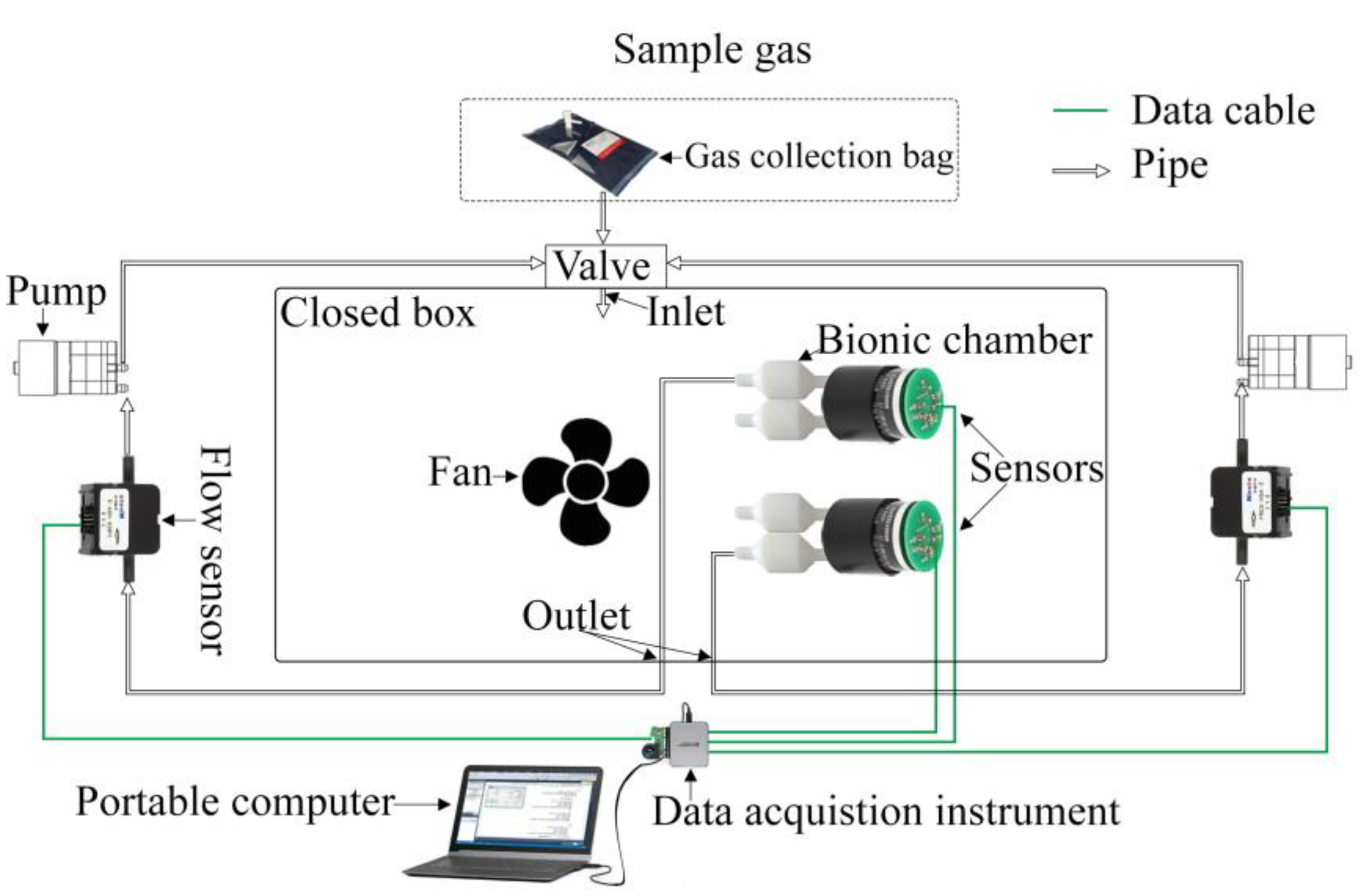
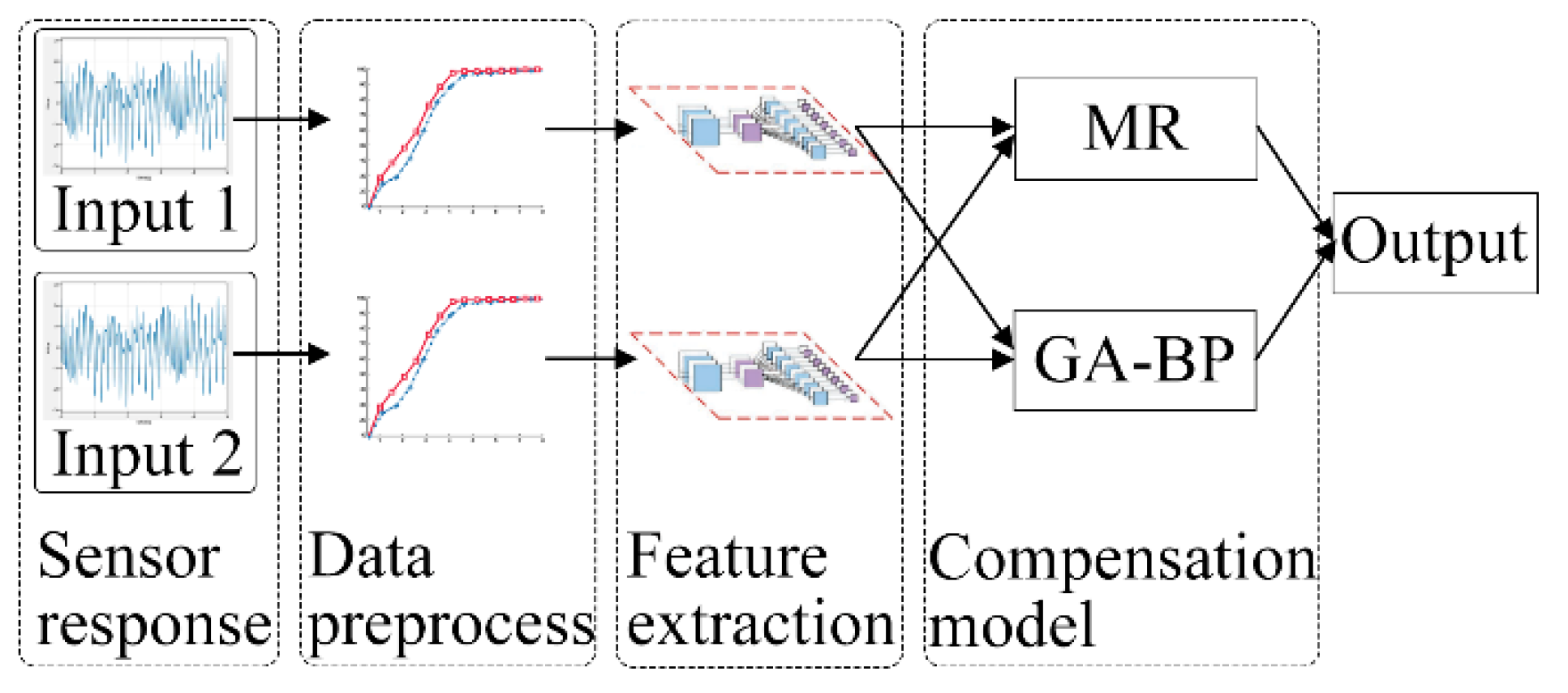



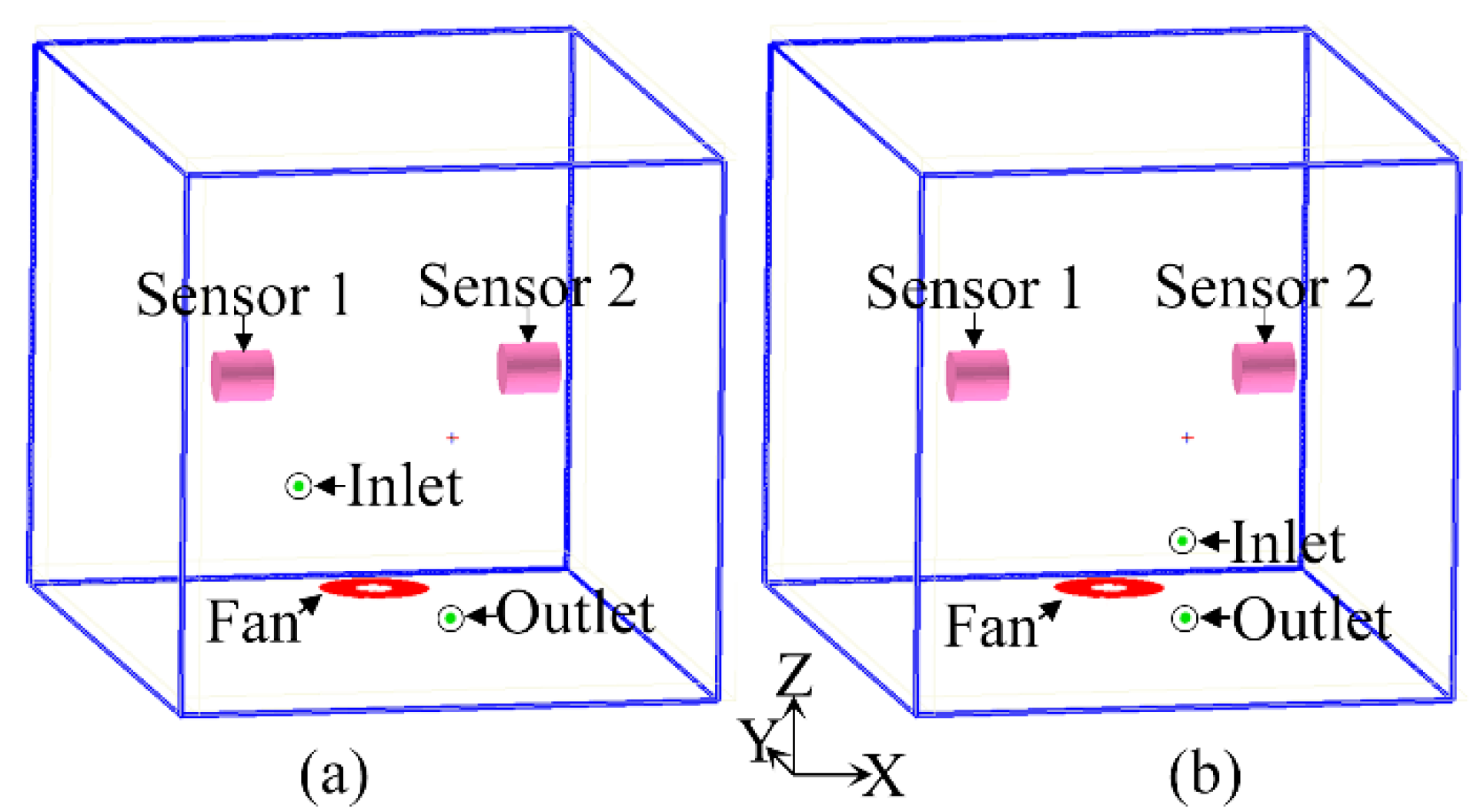
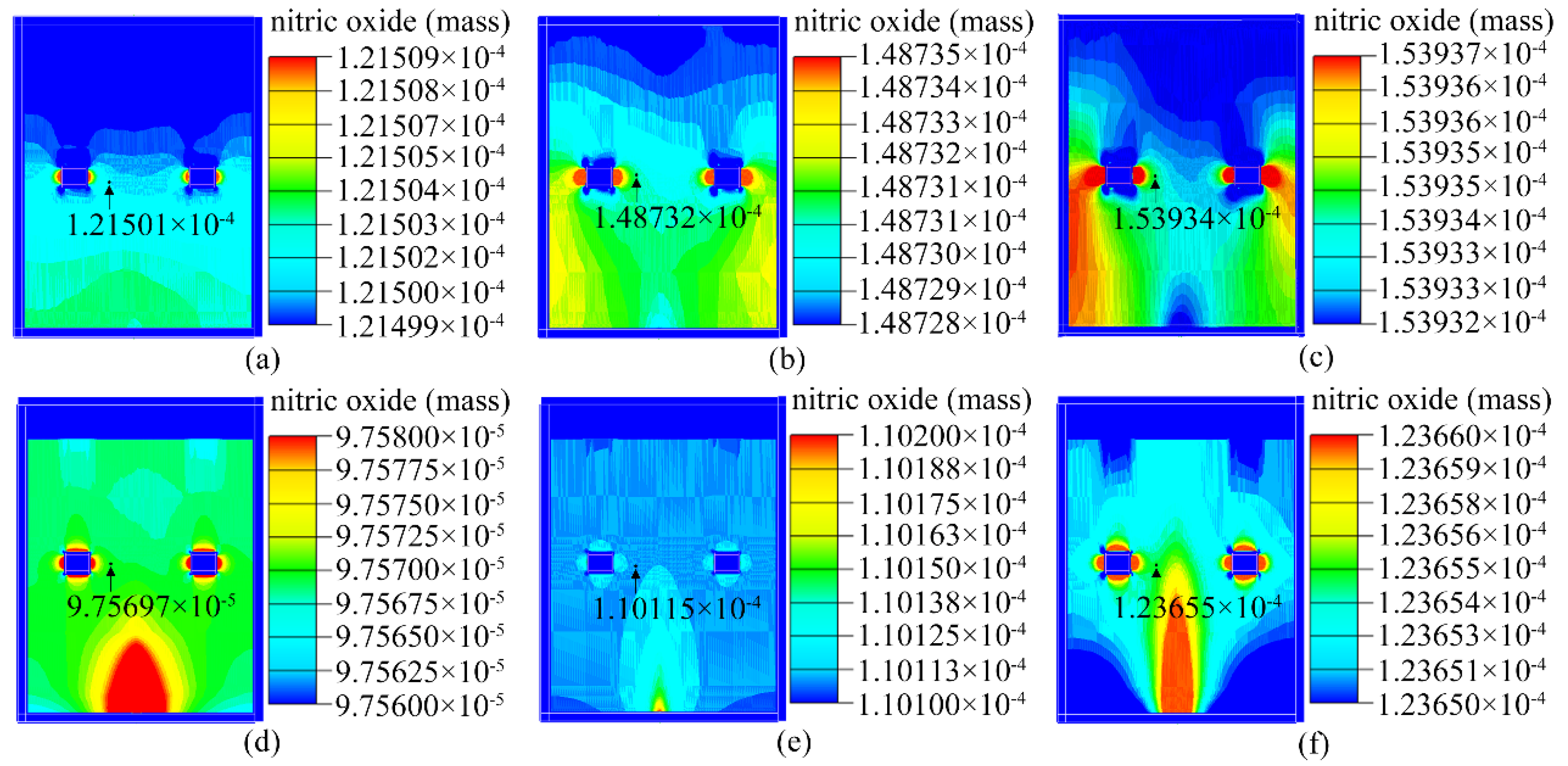


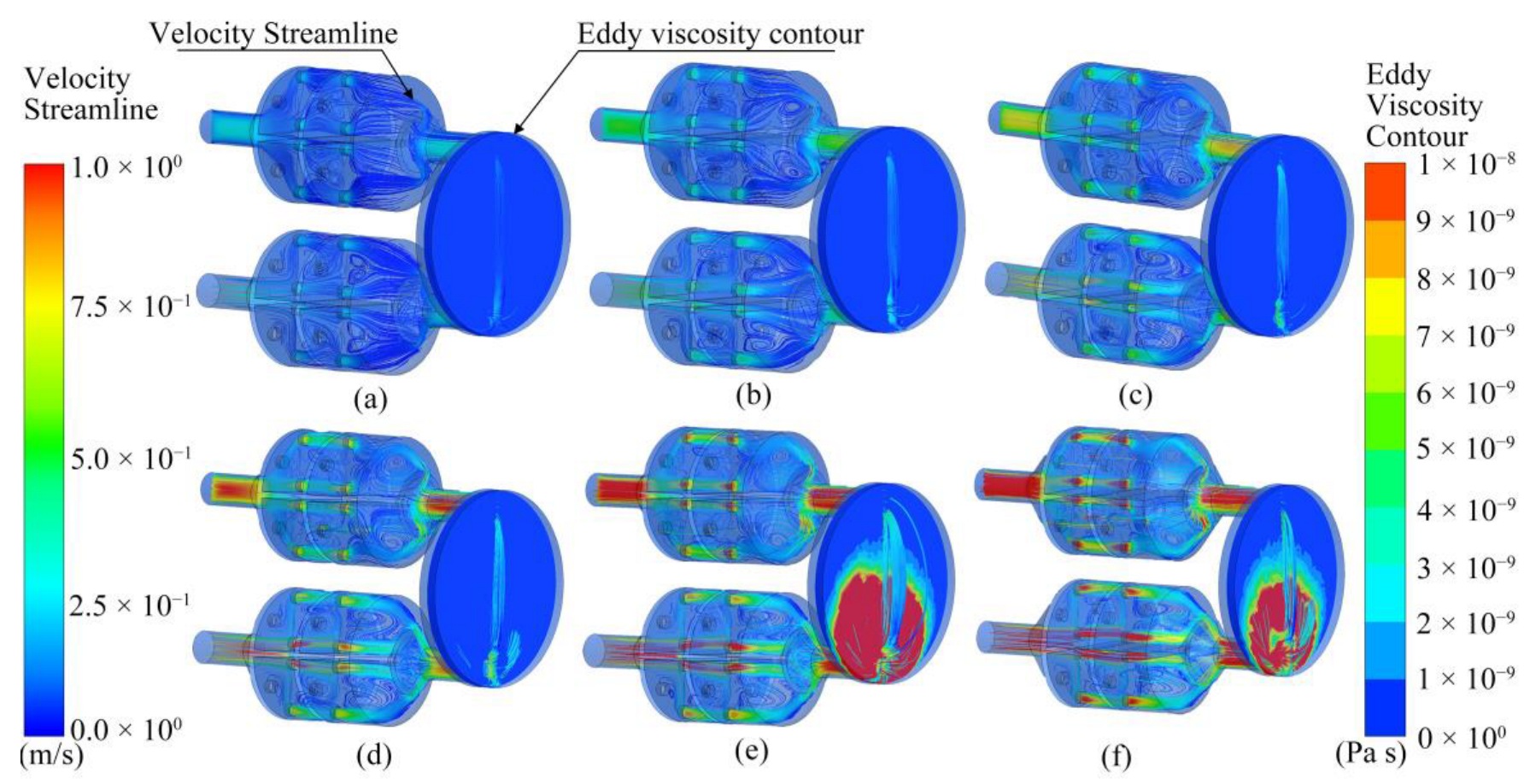

| Simulation Scheme | Closed-Box Structure | Pump Suction (SCCM) |
|---|---|---|
| 1 | type I | 200 |
| 2 | type I | 600 |
| 3 | type I | 1000 |
| 4 | type II | 200 |
| 5 | type II | 600 |
| 6 | type II | 1000 |
| Serial Number | Concentration (ppb) | Flow Capacity (SCCM) | Number of Samples |
|---|---|---|---|
| 1 | 5 | 200 | 2 |
| 2 | 25 | 400 | 2 |
| 3 | 35 | 600 | 2 |
| 4 | 50 | 800 | 2 |
| 5 | 100 | 1000 | 2 |
| 6 | 200 | 1200 | 2 |
| Factor | Mean Square | F | p-Values |
|---|---|---|---|
| Concentration × Flow capacity | 0.009 | 1.328 | 0.153 |
| Concentration | 26.550 | 4070.496 | 0 |
| Flow capacity | 0.078 | 11.964 | 0 |
| Flow Capacity (SCCM) | Number of Cases | Subset | |||
|---|---|---|---|---|---|
| 1 | 2 | 3 | 4 | ||
| 200 | 30 | 0.7930360 | |||
| 400 | 30 | 0.8395970 | |||
| 1200 | 30 | 0.8688020 | 0.8688020 | ||
| 600 | 30 | 0.8868667 | 0.8868667 | 0.8868667 | |
| 800 | 30 | 0.9118807 | 0.9118807 | ||
| 1000 | 30 | 0.9344510 | |||
| p-values | 1.000 | 0.064 | 0.101 | 0.062 | |
| Modified Model | R2 | MSE | RMSE |
|---|---|---|---|
| MR | 0.98768 | 0.094584 | 0.1241 |
| GA-BP | 0.94544 | 0.1956 | 0.26119 |
| Optimized model | 0.99113 | 0.075204 | 0.10531 |
| Concentration | Pre-Correction | MR Combined with GA-BP Algorithm |
|---|---|---|
| 5 | 4.585 | 6.513 |
| 25 | 21.388 | 26.709 |
| 35 | 27.468 | 34.115 |
| 50 | 39.152 | 50.088 |
| 100 | 82.179 | 99.072 |
| 200 | 158.815 | 200.921 |
| Precision (±%FS) | 17.40 | 6.86 |
Disclaimer/Publisher’s Note: The statements, opinions and data contained in all publications are solely those of the individual author(s) and contributor(s) and not of MDPI and/or the editor(s). MDPI and/or the editor(s) disclaim responsibility for any injury to people or property resulting from any ideas, methods, instructions or products referred to in the content. |
© 2023 by the authors. Licensee MDPI, Basel, Switzerland. This article is an open access article distributed under the terms and conditions of the Creative Commons Attribution (CC BY) license (https://creativecommons.org/licenses/by/4.0/).
Share and Cite
Sun, P.; Shi, Y.; Shi, Y. Multivariate Regression in Conjunction with GA-BP for Optimization of Data Processing of Trace NO Gas Flow in Active Pumping Electronic Nose. Sensors 2023, 23, 1524. https://doi.org/10.3390/s23031524
Sun P, Shi Y, Shi Y. Multivariate Regression in Conjunction with GA-BP for Optimization of Data Processing of Trace NO Gas Flow in Active Pumping Electronic Nose. Sensors. 2023; 23(3):1524. https://doi.org/10.3390/s23031524
Chicago/Turabian StyleSun, Pengjiao, Yunbo Shi, and Yeping Shi. 2023. "Multivariate Regression in Conjunction with GA-BP for Optimization of Data Processing of Trace NO Gas Flow in Active Pumping Electronic Nose" Sensors 23, no. 3: 1524. https://doi.org/10.3390/s23031524
APA StyleSun, P., Shi, Y., & Shi, Y. (2023). Multivariate Regression in Conjunction with GA-BP for Optimization of Data Processing of Trace NO Gas Flow in Active Pumping Electronic Nose. Sensors, 23(3), 1524. https://doi.org/10.3390/s23031524







